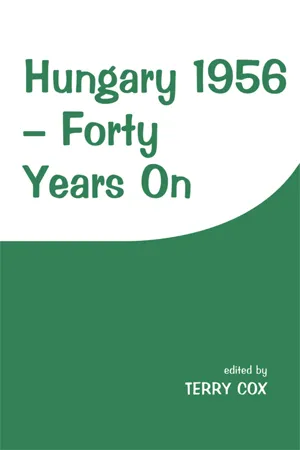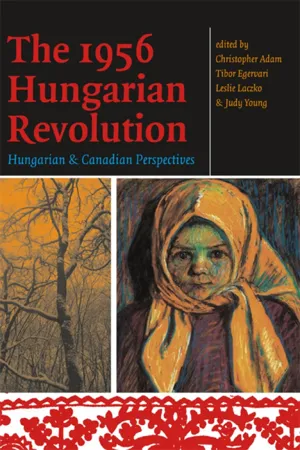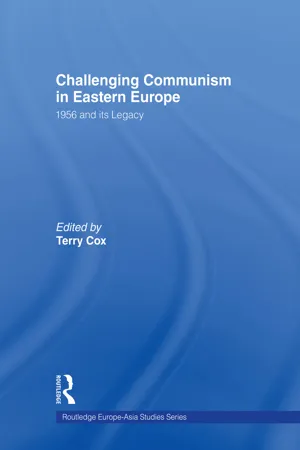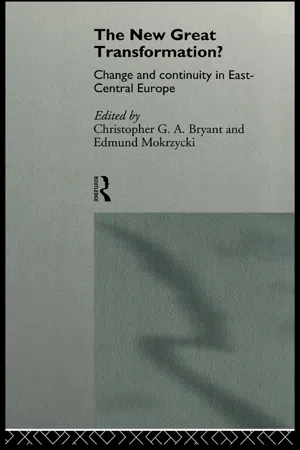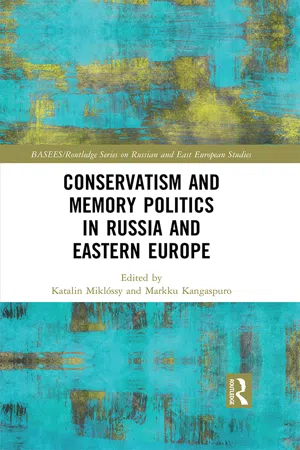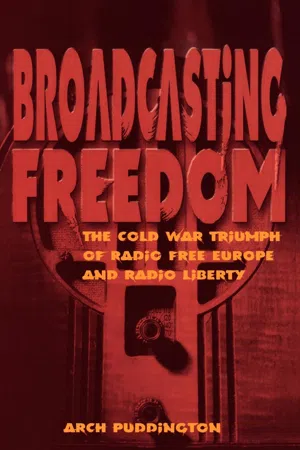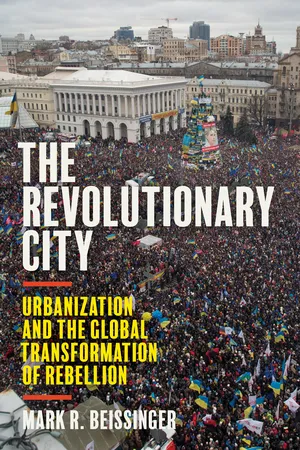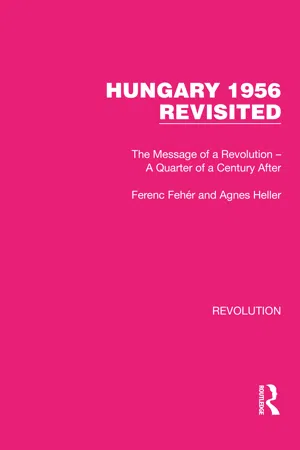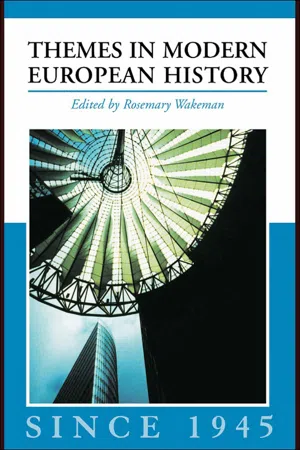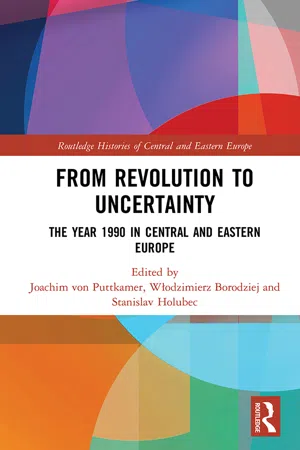History
Hungarian Revolution 1956
The Hungarian Revolution of 1956 was a nationwide uprising against the Soviet-backed Hungarian People's Republic and its policies. It began as a student demonstration and quickly escalated into a full-scale revolt, with demands for political reform and the withdrawal of Soviet forces. The revolution was brutally suppressed by the Soviet Union, resulting in thousands of deaths and mass emigration.
Written by Perlego with AI-assistance
Related key terms
Related key terms
1 of 4
Related key terms
1 of 3
12 Key excerpts on "Hungarian Revolution 1956"
- eBook - ePub
Hungary 1956
Forty Years On
- Terry Cox(Author)
- 2014(Publication Date)
- Routledge(Publisher)
First, we should note that it has only been in the past few years, following a revision of the official view of 1956 by the ruling communist leadership in 1989, that researchers in Hungary have been able to discuss the events of 1956 openly as a revolution. This has been significant in removing artificial fetters on the scope of their inquiries and enabling them to enter into a dialogue with colleagues elsewhere in a context in which they can share and debate the same terminology and conceptualizations. Second, democratization and greater freedom of information in the 1990s have also enabled researchers to gain access to archives and document collections that were previously closed to them, not only in Hungary but also in the Soviet Union and a number of Western countries. This has led to the publication of a range of articles shedding new light on aspects of the decisions and processes underlying the events of 1956. Third, the political changes since the end of the 1980s have created a more supportive climate in which to carry out oral history and to begin to draw on popular memories of how the revolution was intertwined with everyday life and experiences. Finally, interconnected with this range of new research a wider political debate has taken place on the meaning of the 1956 revolution for present-day Hungary and the extent to which it can provide a basis for the creation of a new tradition to legitimate the newly emerged Hungarian political system. To varying degrees the articles collected in this volume reflect these various developments.The Nature and Origins of the 1956 RevolutionThe historical significance of the events of 1956 in Hungary has been widely recognized ever since they first took place. A major reason for this is that, apart from the very early years of communist rule in the Soviet Union, it was the first occasion in which a communist regime met a major challenge from a widespread mass opposition movement. Although linked in its causes and grievances to other expressions of popular discontent and opposition in the years after the death of Stalin – in East Germany, Czechoslovakia, and most notably Poland – the Hungarian events were distinctive in their nature and consequences. In particular they were exceptional in giving birth to a sustained mass movement that briefly promised a genuine share of state power to non-communist parties and the prospect of a radical restructuring of social relations and institutions throughout Hungarian society.The prospects for such radical restructuring that were opened up by the events of 1956 immediately raised the question of whether they could be seen as a revolution. In the years since then there has been much debate on this question but, in essence, three main objections have emerged to the description of 1956 as a revolution. - eBook - ePub
- Christopher Adam, Tibor Egervari, Leslie Laczko, Judy Young, Christopher Adam, Tibor Egervari, Leslie Laczko, Judy Young(Authors)
- 2010(Publication Date)
- University of Ottawa Press(Publisher)
Part I The Revolution, Hungary, and the WorldPassage contains an image
1.The Hungarian Revolution of 1956: Causes, Aims, and Course of EventsJános M. RainerO n October 23, 1956, a revolution broke out in Budapest and spread all over the country in just a few days. The demonstrators, strikers, armed insurgents, leaders of the organizations of the revolution, and their sympathizers, demanded democratic freedoms and national independence. The first modern anti-totalitarian revolution in Europe lasted for practically two weeks, with another four weeks of rear-guard actions. Its impact could, however, be felt directly or indirectly for decades to come, right up to the change of regimes in 1989–1990.I offer here a survey of the antecedents of 1956 from the point of view of political and social history, as well as the history of ideas. This is followed by a brief history of the revolution and an outline of the strata of active participants. Finally, I attempt to characterize the revolutionaries’ aims.AntecedentsThe need for political, economic, social, and mental change became a constant concern of Hungarian public life from the early 1930s, when the Great Depression began to make an impact in Hungary. The solution to the agrarian question, in the form of land reform, was a perennial topic from the end of World War I onward. The great economic crisis and the outbreak of World War II gave an impetus to reformist thinking, as it became obvious that Hungary would necessarily emerge from the war a different country. The dimensions of the war made it clear that Hungary’s subsequent fate would be greatly determined by the superpower in control of the East-central European region.In 1944 Hungary became part of the Soviet sphere of influence. This fundamentally determined Hungary’s domestic and foreign policy, as well as its social and economic development between 1944 and the late 1980s. All issues that were believed to interfere with Soviet military and political interests and security were decided by the Soviets. Hungarian political life was independent as long as it did not go beyond the limits of this system and remained in harmony with Soviet demands. Whenever a conflict arose, Soviet interests enjoyed absolute priority.1 - eBook - ePub
Challenging Communism in Eastern Europe
1956 and its Legacy
- Terry Cox(Author)
- 2013(Publication Date)
- Routledge(Publisher)
Hungarian were examined, the 1956 Revolution would be prominent among them. It is perhaps the best known event in the country’s twentieth-century history, for obvious reasons. First of all, this is the one internationally significant event with a Hungarian dimension that has taken place within living memory. In the West, 1956 took place in the modern media age, so that it was a decisive experience for many important figures in today’s political, cultural and literary life.It was also a positive experience, with appreciable significance, in contrast to the pre-revolutionary image of Hungary and the Hungarians, which had hardly been flattering. Indeed, Hungary’s image had tended to be unfavourable since the turn of the nineteenth and twentieth centuries (Jeszenszky 1986; Evans 2003; Molnár 2001); little occurred between the two world wars to improve it; and Hungary’s wartime alliance with Hitler had done it further damage. Although the Soviet occupation had made the country a victim, that did not alter the image of the Hungarians very much (any more than the praiseworthy efforts of the Hungarian democratic émigré community did).What did result in a change to that image was the 1956 Hungarian Revolution. However, the picture was still one-sided: it now became quite positive but remained one of Hungary as perceived in 1956. The strongest signal that the subjugated societies of Eastern Europe were straining against the Soviet-type system had come from Budapest, but the kind of nationalism to breach the peace of the region did not emerge in 1956. (This had been a persistent, often unjust and exaggerated charge against the Hungarians in earlier decades.) Although the revolution failed, it brought clear victories later on: in the shape of a reformed, more human and liveable type of socialism. The detrimental side of the defeat, on the other hand, was soon forgotten, or remained concealed. The reprisals aroused widespread international outrage but this did not last long and was seldom mentioned after the amnesty of 1963. ‘Fifty-six’ made Hungary ‘different’ in the eyes of the West, distinguishing it from the seeming uniformity of ‘Eastern Europe’. Indeed, Hungary was different, but not as different as Poland, which revolted every 12 years. The 1956 Revolution was scored as a factor in favour of Hungarian society, even though there remained a nimbus around its post-1956 leader, János Kádár, who had defeated the revolution.4 - eBook - ePub
The New Great Transformation?
Change and Continuity in East-Central Europe
- Christopher Bryant, Edmund Mokrzycki(Authors)
- 2002(Publication Date)
- Routledge(Publisher)
The advocates of a second revolution are thus not sure if they wish for a revolution of civil society from below, or a state-led revolution from above. This dilemma is, of course, inherent in the Jacobin-Bolshevik tradition. Hungary’s new Jacobins reject this tradition all the same, even if their rhetorical devices—like Csurka’s constant talk of national and international conspiracy, Kónya’s implied distinction between the empirical and the authentic people, and the very different calls for a real or second revolution—very much resemble intellectual devices of that tradition. But in Hungary, after forty years of a Bolshevik or neo-Bolshevik regime, any positive references to its heritage remain off limits. This effects the semantics of key actors. No one describes himself or herself as a revolutionary, nor are actions, institutions, events or processes so described. The semantical revival inherent in the talk about conspiracy, enemies, and counter-revolution remains partial. The young activists of Fidesz who eschew all such terminology are far more characteristic of the population than the populist demagogues who selectively use it. All the same, even the selective use is striking given that the most revolutionary rhetoric comes from the most determined anti-communists.One explanation lies in the fact that Hungary has another revolutionary tradition, symbolized by the dates 1848 and 1956, which indeed belongs to the central symbolic core of national politics. The power of their interrelated heritage is by no means exhausted. Every Hungarian regime since the Compromise of 1867 has tried to use the symbols of 1848 for its own legitimating purposes. The commemoration of its initiating events on 15 March has been an important contested ritual from the nineteenth century to the communist regime (which de-emphasized the holiday) to the dissidents of the 1980s (who tried to revive it) (Hofer, 1992). Similarly, even small demonstrations on 23October and 16 June, two central dates commemorating 1956 and its bloody defeat, were important for the opposition when it sought to delegitimate the Kádárist regime. The official redefinition of 1956 as a national uprising, and the national reburial of Imre Nagy and his comrades on 16 June 1989, completed this process of delegitimation.Nevertheless, reference to the heritage of 1848, and even more to 1956, has not been easy (Pomogáts, 1992). To an extent, they both belonged to the classical tradition of revolutions and attempts to redefine them within the context of the new East European politics of self-limitation have not been particularly convincing. Kossuth and his collaborators were not ‘constitutional revolutionaries’ since there was no modern constitution whose rules they could use for change, and they sought to overthrow the heritage precisely of estate Hungary (Hofer, 1992:38). Nor was the idea of revolutionary dictatorship far from their minds once they were in open war with foreign invaders. Similarly, while it may have been technically correct (and politically understandable in 1986) to make the workers’ councils after the second Soviet intervention of November 1956 into forerunners of the self-limiting revolution of Solidarity, the parallel remains artificial and selective given the whole context of 1956 (Kis, 1989). Neither 1848–49, nor especially 1956, can be made sense of within a model of non-violence. Moreover, in 1989 no important political force was willing to revive crucial aspects of the political programmes of 1956, especially the elements of direct and industrial democracy and of dual power. The influence of the radical democratic ideas of Istvan Bibó, the leading political philosopher of 1956, was negligible in 1989 in spite of his great importance for both the populist writers and the democratic opposition of the 1980s. - Katalin Miklóssy, Markku Kangaspuro, Katalin Miklóssy, Markku Kangaspuro(Authors)
- 2021(Publication Date)
- Routledge(Publisher)
In the dramatic year of 2015, Prime Minister Orbán was abroad dealing with EU pressure on a summit about migration, hence he did not attend the commemoration, yet his message was heard. The Minister of Defence, István Simicskó on behalf of the government, held a watershed speech where he moved the responsibility of the failed revolution from the Soviet Union to the West. He underlined that 1956 was needed because after World War II “the victorious world powers had already agreed that Hungary would become part of the Soviet sphere of interest, and the Hungarians were not consulted, the decision was made over their heads, the country was handed over to a dictatorial system…”. In addition, he stated that “The world sent many statements and promises of solidarity in 1956, yet the country was left to fend for itself and the revolution was left to fight alone, because although gestures were made, no help arrived from abroad”. 56 The role of the Russians in the suppression was not even mentioned. The same message was repeated in 2016, which was declared officially as a commemorative year with significant funds channelled into the festivities, emphasising the country’s freedom-fighter image. 57 While the confrontation with the EU was escalating, in his speech at the 60th anniversary of the Revolution, Viktor Orbán reminded his listeners that the Hungarians fought against Soviet-type communism and the Soviet empire, and the Revolution showed the West that the Soviet Union can be wounded. The memory of this freedom fight obliges the Hungarians “to save Brussels from Sovietisation and the European Union turning into a new empire”. 58 With these statements, Prime Minister Orbán intended to underline two things: on the one hand, threats for Hungarian integrity came from the West, and secondly, he did not identify the Soviet past with contemporary Russia. His words were obviously differently interpreted in Moscow and too many mentions of the Soviet yoke were irritating- eBook - ePub
The Roots and Consequences of Independence Wars
Conflicts That Changed World History
- Spencer C. Tucker(Author)
- 2018(Publication Date)
- ABC-CLIO(Publisher)
Pressed by German chancellor Adolf Hitler, who promised the return of some of its prewar territory, Hungary joined the Axis side in World War II and again suffered defeat and, this time, Soviet occupation. Soviet tanks crushed a new revolutionary effort in 1956, and Hungary remained part of the Soviet empire. Hungary can be said to have regained full independence only with the end of communism in 1989.SPENCER C. TUCKERTimeline Jul 1847Austrian troops occupy Ferrara, inflaming Italian nationalists. Late 1847An agricultural crisis in much of Europe becomes a widespread economic crisis. Feb 24, 1848French king Louis Philippe I abdicates, and a republic is proclaimed. Mar 3, 1848Hungarian nationalist leader Lajos Kossuth attacks Austrian rule and demands reforms to include the establishment of a constitution and responsible ministry in Hungary. This marks the beginning of the Hungarian Revolution.Mar 13, 1848In Vienna, inspired by events in Paris and in Bratislava, students demand reform in Austria and are joined by workers. Metternich is forced to resign and flees Vienna. Mar 15, 1848A large crowd in Budapest seizes control of government buildings and demands reforms. They also force Austrian representatives to agree to the 12 Points, which call for Hungarian independence and reforms.Apr 1848A Hungarian Diet convenes in Pozsony and enacts the so-called April Laws, in effect a new constitution that establishes a constitutional monarchy. May 1848Emperor Ferdinand and the Austrian court leave Vienna for Innsbruck, where they rally the peasantry and the army. Jun 2–12 1848A Pan-Slav assembly meets in Prague. Jun 17, 1848Austrian troops led by Alfred I, Prince Windisch-Grätz, take control of Prague. Sep 17, 1848Having been appointed commander of Austrian forces against Hungary, Croatian baron Josip Jelačić leads Croatian forces into Hungary to put down the rebellion there. Sep 29, 1848At Pákozd, Hungarian forces under General János Móga defeat Austrian Crown forces under Jelačić. An armistice is then arranged. - eBook - ePub
- Jason Sharman(Author)
- 2004(Publication Date)
- Routledge(Publisher)
4 The Hungarian UprisingThe Hungarian Uprising of 1956 marked the most severe challenge posed by dissident collective action for a Communist elite until 1989. In the face of an insurrection in the capital city and throughout the country, the oneparty system in Hungary was swept away, and for a few days the insurgents looked to have succeeded in their goal of a democratic, neutral and independent Hungary. But after a massive Soviet military intervention the ancien régime was restored, and the process of demobilizing organized opposition and rebuilding the institutions of power begun. That these goals were achieved and the system re-equilibrated seems all the more remarkable given the depth of popular alienation from the regime, as expressed in the uprising, and the degree of loathing and contempt for the new rulers installed by a foreign hegemon. As with the previous and the subsequent case study, the question posed is how the regime could maintain itself in power with such a slender base of support.Once again the answer is sought in examining how the particular features of the Communist system shaped people’s repertoire of contention. The absence of resources with which to organize dissenting collective action, the depth of social isolation, and the power of the state’s coercive and surveillance institutions greatly inhibited the transition from disaffection with the government to public contention. Not only did these circumstances prevent public expression of grievances before 1956 and facilitate the repressive measures from November 1956 onwards, but they also stamped the character of the uprising itself. Not only did deep-seated and widely held grievances thus coexist with social peace before and after the revolt, but the strategies adopted by dissidents during the uprising tended to rely on simple expedients that did not depend on extensive resources or a sophisticated organizational basis. - eBook - ePub
Broadcasting Freedom
The Cold War Triumph of Radio Free Europe and Radio Liberty
- Arch Puddington(Author)
- 2021(Publication Date)
- The University Press of Kentucky(Publisher)
6Revolution in Hungary and Crisis at Radio Free Europe
During the entire Cold War in Eastern Europe, no single event produced as much death and destruction as the Hungarian Revolution. The immense human toll included between ten and twenty thousand dead, and thousands more wounded, imprisoned, deported to the Soviet Union, or forced into exile. The revolution also destroyed many of the assumptions on which American policy toward the satellite regimes was based, or seemed to be based. Having stood aside, impotently, as the Red Army ruthlessly smashed the first real attempt to overthrow the yoke of Communist oppression, the United States was to abandon all pretense that its policy was driven by the rollback of Soviet imperial authority or the liberation of the satellites. After Hungary, America was to essentially concede Soviet domination of the region, more or less for the remainder of the Cold War, so that when America challenged Soviet expansionism, the venue would be in Third World outposts such as Vietnam, Angola, or Nicaragua. Washington never again gave serious consideration to disputing Moscow’s hegemony in its own back yard, even when Poles or Czechoslovaks rose up to demand freedom and national independence.The Hungarian tragedy was also to have serious consequences for the projects that America set in motion to wage war against communism—literal war, in the case of the émigré fighting units that Frank Wisner was training in various European bases. (The units were dismantled in the revolution’s aftermath.) But the deepest wounds were to be suffered by Radio Free Europe.1 Before the revolution, RFE was a respected and valued institution of American Cold War strategy; after Hungary, RFE’s reputation would be forever tarnished, as historians, diplomats, and journalists accused the station of having made a bad situation worse or, in the most extreme cases, of actually having triggered the revolution through shrill and irresponsible broadcasts. The latter charge is unfair. Communist oppression caused the revolution, not American propaganda; and Americans typically exaggerate their own power and the power of their institutions. Nevertheless, the charge of incitement became embedded in Cold War mythology; one latter-day commentator even coined the phrase “Radio Free Europe syndrome” to describe situations in which the United States eggs on a tyrannized people to rebellion without providing the means for victory.2 - eBook - ePub
The Revolutionary City
Urbanization and the Global Transformation of Rebellion
- Mark R. Beissinger(Author)
- 2022(Publication Date)
- Princeton University Press(Publisher)
But no one should enter into revolution with the illusion that it will resolve the fundamental conflicts and trade-offs inherent in the human condition. Revolutions are well known to be accompanied by an explosion of hopes and expectations. Yet they are equally associated with disappointment and disillusionment. We should not be surprised that the record of revolutionary movements that have managed to gain power in achieving substantive change has been mixed. Some have introduced sweeping, lasting change. Others have effected only minor modifications or change that proved short-lived. Some regimes brought to power by revolution have endured for decades. Others barely lasted for months. Sometimes post-revolutionary change has come at a high price, costing more lives than were lost in revolutionary contention itself; even those instrumental in bringing the new regime to power can be among the individuals suffering the most. As is true of politics more generally, advancement in one area often comes at the cost of deterioration in another. Moreover, most revolutions bring with them consequences completely unanticipated by revolutionary participants, opponents, and observers. The path of substantive change in the wake of revolution has never been straight. It has always been arduous, circuitous, and contested—with detours, roundabouts, and dead ends.Take, for instance, the case of the Hungarian Revolution of 1919. After two months of major strikes, riots, and street protests, a coalition of communists and social democrats led by Bé la Kun forced the resignation of the democratic government of Mihá ly Ká rolyi and proclaimed a Hungarian Soviet Republic in March 1919. The new government enacted a dizzying array of changes: it nationalized land, industry, housing, and commercial enterprises; abolished aristocratic titles and privileges; and declared healthcare and education free. But the inflation and food shortages that ensued quickly led to the collapse of the revolutionary coalition. Kun resorted to terror to prop up his regime, and Czechoslovak and Romanian troops invaded, forcing Kun to flee after only 134 days in office.3 Cases like the 1919 Hungarian Revolution often lie forgotten in the annals of revolution. Their main contribution lay in how they precipitated what followed—in the Hungarian case, the repressive and semi-fascist regime of Admiral Horthy that dominated Hungarian politics for more than two decades.In the history of revolution, stories like Bé - eBook - ePub
Hungary 1956 Revisited
The Message of a Revolution – A Quarter of a Century After
- Ferenc Fehér, Agnes Heller(Authors)
- 2022(Publication Date)
- Routledge(Publisher)
reorganised) party declaring 23 October the day of a glorious uprising restoring Hungarian freedom and national independence. Kádár, one of the most suspicious minds ever involved in Hungarian political life, who, as a prisoner for many years, had learned the Russian lesson the hard way, was hardly the man to be lured into such a gravely incriminating statement without both prior consultations with Andropov and the belief that there was at least a chance of the ‘Finlandisation’ of Hungary (in which case, of course, he did not want to find himself totally out of power as a hardliner Stalinist). To our mind, all of this confirms that the Hungarian revolution did have a chance of lasting success, provided that three factors were simultaneously present: a collective-national Hungarian readiness for a measure of compromise (particularly in matters regarding Soviet strategic interests, and readiness in this respect has been amply proved by us); a convincing signal on the part of the Western, and in particular of the American, governments that détente would be initiated forthwith (and its absence has equally amply been proved by us); plus the combined pressure on the part of Chinese, Yugoslav, Italian and French communists on the Soviet government to come to terms with the Hungarian defeat. We know where we stand as far as the third prerequisite is concerned. Bibó makes the following short statement on the cause of the events becoming revolutionary: But, anyhow, the fact that the Hungarian revolution gained momentum was not a result of its own insensibility but of the foolhardiness and bloodshed provoked by the leadership and the secret police forces; and the revolution, despite its being unprepared and unorganised, when seen as a response to bloodshed, was remarkably sober, humane and moderate. 14 Though this much is undoubtedly correct, a full understanding requires a much longer and more complex explanation - eBook - ePub
- Rosemary Wakeman(Author)
- 2003(Publication Date)
- Routledge(Publisher)
14The Polish and Hungarian collapse had fatal consequences for communist regimes throughout Central and Eastern Europe. Gorbachev’s Soviet Union accepted the political changes, thereby confirming the disappearance of any threat of Soviet military intervention. Communist elites were totally demoralized after recognizing that neither military force (martial law in Poland), nor radical and successful reforms (as in Hungary) were able to shore up a decaying and corrupted system. In this political environment, only a small spark was necessary to ignite and destroy state socialism in East Germany, Czechoslovakia, Bulgaria, and Romania within a few weeks. The opening of the Hungarian—Austrian border in September 1989 lit that spark. This act was part of the peaceful Hungarian revolution. It was mostly symbolic, since all Hungarians had passports and were able to travel freely. The Németh government, however, sought to acknowledge this freedom by destroying the marks of a closed society: the barbed wire fences and watchtowers along the Austrian border. Yet this symbolic act eliminated a very real obstacle to escape for East Germans who were forbidden to travel to the West and instead spent their vacations in Eastern Europe. Hungary was a popular destination for families from both Germanies. Once the border was opened, tens of thousands of East Germans streamed across from Hungary into Austria in the early weeks of summer. The Hungarian government rejected the 1969 agreement preventing East German citizens from leaving to a third country and instead negotiated with the Kohl administration in West Germany to organize the mass migration. An exodus, a “vote by foot,” swept away Eric Honecker s hard-line government in East Germany. Mass demonstrations by millions followed in Dresden, Berlin and other cities. Personal changes in the top leadership became meaningless in this situation. To stop the exodus, the demoralized communist leadership opened the Berlin Wall on November 9, 1989. The symbol of German division and the Cold War separation of Europe was destroyed. Deutschland, einig Vaterland, - eBook - ePub
From Revolution to Uncertainty
The Year 1990 in Central and Eastern Europe
- Joachim von Puttkamer, W?odzimierz Borodziej, Stanislav Holubec(Authors)
- 2019(Publication Date)
- Routledge(Publisher)
6 Talkin’ ’bout a revolution On the social memory of 1989 in Hungary Éva KovácsWas 1989 a memorable year in Hungary? Currently, the year of the regime change does not play a formative role in memory politics. However, it was once annus mirabilis for many Hungarians. On the contrary, it is now retrospectively referred to as annus miserabilis : the defeat of young Hungarian democracy by global capitalism. This essay describes the divergence between the memory of the fall of communism as an exhilarating event and its depressing aftermath as an irreversible development in the Hungarian memory landscape.1By analyzing the political involvement of Hungarian society at the very moment of regime change, dozens of national and local events can testify to the formative character of the political transition from the perspective of the people at large. Retrospectively, however, the transition did not fulfil their expectations. The 1989 revolution brought about a euphoric rite de passage between the past and the present. It was not immediately apparent that anti-communism would parallel not only the refusal of previous political values, but also the quick devaluation of former lifestyles, social milieus, and mentalities; that is to say, many people had to negate their former life. Therefore, for those who were unable to follow the road of radical stigmatization of the ancien régime , the disqualification of everyday life under socialism resulted in the ‘passive forgetting’2 of the whole era in collective memory. Ten years later, with emerging poverty, the deterioration of political and economic prospects and the actual living conditions, passive forgetting turned into a retrospective idealization of the communist regime and a generalized criticism of capitalism.Currently, 1989 is not considered a historic year in Hungary. It does not play a formative role either in public history or in memory politics. Although some of its significant days – e.g. 15 March, 16 June, 23 October, and 26 November 1989 – once marked important events in the transition from communism, today they do not inspire either social memory or current social action. Because 1989 symbolized the miraculous end of communist regimes, the term annus mirabilis was once widely used to describe the political events that took place in Eastern Europe. Today, however, it is often referred to – by the very same intellectuals who once championed it – as annus miserabilis:
Index pages curate the most relevant extracts from our library of academic textbooks. They’ve been created using an in-house natural language model (NLM), each adding context and meaning to key research topics.
Explore more topic indexes
Explore more topic indexes
1 of 6
Explore more topic indexes
1 of 4
